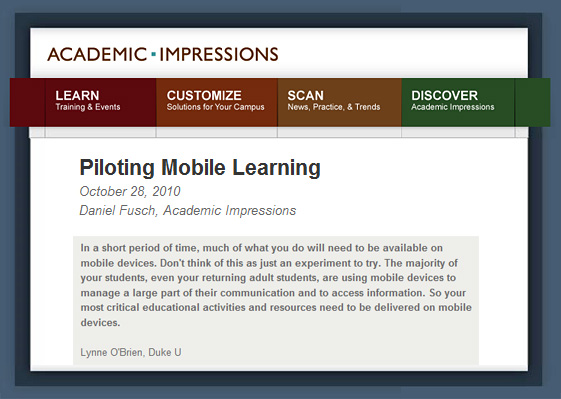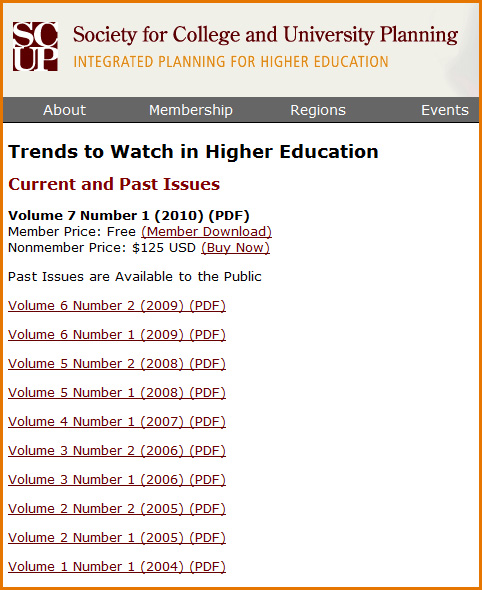The Data Analytics Boom — from Forbes.com by John Jordan
A multitude of converging facts has given rise to numbers-based decision-making.
Web 2.0’s Foundation of Sand — from CampusTechnology.com by Trent Batson
From DSC:
Below is the excerpt I want to point out:
The lessons of our experience, and perhaps of the experience of others, is that startups and other initiatives without venture capital that may need to depend on free Web services to get started must at some point move to commercial sites. The Web, where information wants to be free, and which is wildly creative, innovative, vital, and powerful, offers a great ride. But it is also highly transient with Web apps coming and going, metamorphizing, being bought, or not staying current.
From DSC:
The world of IT is very complex right now (with no signs of getting any less complex) — and things are constantly changing. Thus, when building or maintaining one’s learning ecosystem, you WILL experience changes in applications, services, vendors, and features sets. Such things will come and go (think Google Wave for example). Technologies evolve. Change WILL happen. Some services and vendors won’t make it or will be purchased. Count on such things happening, stay flexible, adaptable and responsive; try to make backup plans for each product/service/vendor that you possibly can.
5 things Netflix streaming can teach higher ed — by Joshua Kim
1. Replace Yourself:
Where can we replace ourselves in higher ed, before someone else does it for us?
2. Service Tomorrow:
Do we have a good idea how education will be constructed, delivered and consumed in the future?
3. Experience, Not Technology:
How can we in higher ed focus on the experience of learning, as opposed to the delivery mechanism?
4. Be Fearless:
How can we be more fearless in higher ed, and be willing to take risks for our students?
5. Design For Your Customer:
Are we in higher ed offering enough choices for how our students’ want to consume and participate in learning?
From DSC:
In reading Ray Ozzie’s views of the future (Ray is the departing high-level visionary at Microsoft), it was interesting to note that Ray points out the dangers of complexity — at least in the world of computing/software development. Quotes from both 2005 and 2010 are below:
Complexity kills. It sucks the life out of developers, it makes products difficult to plan, build and test, it introduces security challenges, and it causes end-user and administrator frustration. Moving forward, within all parts of the organization, each of us should ask “What’s different?”, and explore and embrace techniques to reduce complexity.
Complexity kills. Complexity sucks the life out of users, developers and IT. Complexity makes products difficult to plan, build, test and use. Complexity introduces security challenges. Complexity causes administrator frustration.
Patterns emerge over time — from Harold Jarche
Andrew Cerniglia has an excellent article that weaves complexity, cynefin and the classroom together. It is worth the read for anyone in the teaching profession. I became interested in complexity as I moved outside the institutional/corporate walls and was able to reflect more on how our systems work. The observation that simple work is being automated and complicated work is being outsourced seems rather obvious to me now. Complex work that has increasing market value in developed countries and that is where the future lies. However, our schooling, training and job structures do not support this.
Cerniglia explains how complex the classroom can be, when we factor in the outside that touches each student daily…
Also see:
5 lessons from outgoing Microsoft software architect Ray Ozzie — from Fast Company by E.B. Boyd
From DSC:
Key quotes that directly relate to those of us in higher education:
1. Take time to paint a vision of the future
2. Put past successes “in perspective”
Once a company has done something well, it’s easy to keep doing that thing. In fact, it’s hard to stop doing it, because your company–its structure and incentives–get organized around enabling that successful thing to keep happening. But if the bigger picture in your industry changes, as it is in the tech sector, that successful thing may no longer be optimized to the new environment. Continuing to do it (from DSC: i.e. the status quo), and not shifting to a product line better suited to the new landscape, will put you at a disadvantage against competitors who do adapt, not to mention new entrants who have designed themselves with the new needs front of mind.
…
“This will absolutely be a time of great opportunity for those who put past technologies & successes into perspective,” Ozzie writes, “and envision all the transformational value that can be offered moving forward.”
3. Recognize what’s inevitable in your industry
The flip side of putting past successes in perspective is recognizing what new developments are inevitable. The news industry, for example, spent a lot of time fighting the Web and digital news before finally accepting their inevitability. Think of how much energy would have been saved–and, more, put to better use–had the industry sought to dive into the digital world, rather than fight it.
4. “Inevitable” is not the same as “imminent”
5. Real transformation has to come from within
Also relevant here:
- Dawn of a New Day by Ray Ozzie (Oct 2010) — for his look at what’s coming down the pike and
- Ray’s memo from 2005 entitled, The Internet Services Disruption
WGU growing 30% annually — from edreformer.com by Tom Vander Ark
Here’s why WGU is cranking: the average time to a bachelor’s degree is 30 months—about twice as fast as a traditional college. Speed to degree results from:
- Willingness to accept transfer credits
- Ability to test out of subjects where students have experience
- The online instruction allows students to move at their own pace
The teachers college is the largest; business, IT, and health are all growing rapidly.
Welcome, now start slashing — from InsideHigherEd.com by Jack Stripling
Hiring provosts who will be immediately charged with budget-cutting presents dilemma for presidents, who debate whether task is best suited for someone new.
The economic downturn presents a stark dilemma for colleges and universities seeking provosts, and presidents are somewhat split on whether to move forward. On the one hand, bringing in someone with fresh eyes who’s not attached to any sacred cows on campus makes sense. On the other hand, thrusting new chief academic officers into situations where they may be immediately tasked with cutting programs, increasing workloads or laying off employees sounds to some like a recipe for burnout or failure.
What’s going to happen when your leaders start retiring in the next five to 10 years? — from ASTD.org by Tora Estep
.
Think about it: 78 million baby boomers are set to turn 65 over the next two decades, and they will crowd the doors as they start walking out. Think about your organization: What’s going to happen when Bob, the CFO, decides he’s done plenty in his career and is ready to move on and start a vineyard? What happens when Mary, the CEO, announces her retirement to sail around the world on a catamaran? What happens when your directors of training, marketing, production, R&D, and so forth leave? What will the day-to-day functioning of your organization look like, let alone your strategy? Is your organization ready to fill the gaps that those people are going to leave?
CIOs are change agents for a more collaborative, virtual workplace — ASTD.org
(From PRNewswire) — Cognizant, a leading provider of consulting, technology, and business process outsourcing services, announced today the results of a research report, “Next-Generation CIOs: Change Agents for the Global Virtual Workplace.” The Economist Intelligence Unit conducted the research across Europe and North America and wrote the report, in cooperation with the Cognizant Business Consulting practice.
The report reveals the CIO’s role in restructuring how work is done throughout the organization. Among the more than 400 survey respondents, mostly CIO, CEO, vice president, and director-level, those who are moving toward more virtual, collaborative teams are benefitting from increased innovation, more effective talent recruitment and retention, and higher productivity. One in six said their companies are already seeing these results, and another one-fifth expect to garner benefits within a year.
Defining one’s performance
Performance is not hitting the bull’s-eye with every shot, that is a circus act.
Performance is not hitting the bull’s-eye with every shot. Performance is rather the consistent ability to produce results over prolonged periods of time and in a variety of assignments. A performance record must include mistakes. It must include failures. It must reveal a person’s limitations as well as his strengths.
The one person to distrust is the one who never makes a mistake, never commits a blunder, never fails in what he tries to do. Either he is a phony, or he stays with the safe, the tried, and the trivial. The better a person is, the more mistakes he will make — for the more new things he will try.
From DSC:
This is not just true in the corporate/business world, but it is also true for all of us who create and deliver educational content — we will make mistakes, we need to be able to experiment and try things. We need to be able to mess up in front of our students and be ok with that. We are all learners…and in my mind, experts are a dying breed; the world’s spinning too fast to be an expert in most things anymore.
The faculty I really love to work with try things — they don’t care if they make mistakes, as they (and I) consider that a given. I don’t know everything about each tool, nor do I expect others to know even 25-50% of the features that any given tool offers (I list a range here due to the variety of learning curves and feature sets out there.)
Results That Make a Difference
What results have to be achieved to make a difference?
The decision about “What should my contribution be?” balances three elements. First comes the question: “What does the situation require?” Then comes the question: “How could I make the greatest contribution, with my strengths, my way of performing, my values, to what needs to be done?” Finally, there is the question: “What results have to be achieved to make a difference?” This then leads to the action conclusions: what to do, where to start, how to start, what goals and deadlines to set.
From DSC:
This reminds me of the work of Marcus Buckingham, in which he stresses the need to go with one’s strengths.













